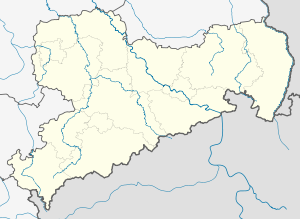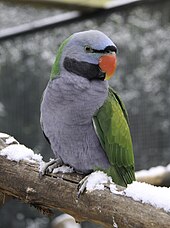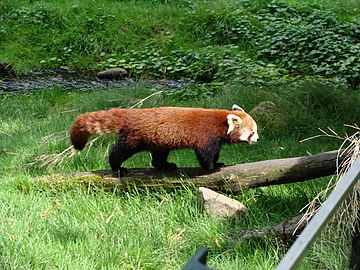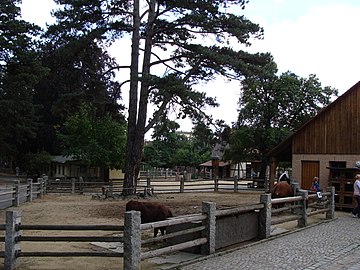Goerlitz Zoo
| Goerlitz Zoo | ||
|---|---|---|
| Full name | Nature conservation animal park Görlitz-Zgorzelec | |
| particularities | Tibetan village, many walk-in enclosures, grass / hay feeding by visitors | |
| place | Zittauer Str. 43 02826 Görlitz |
|
| surface | 5 hectares | |
| opening | 1957 | |
| Animal species | 88 species | |
| Individuals | 550 animals | |
| Species focus | Wildlife and domestic breeds, v. a. from Europe and Asia | |
| Visitor numbers | 145,680 (2018) | |
| organization | ||
| management | Sven Hammer | |
| Sponsorship | Nature Conservation Zoo Görlitz e. V. | |
| Funding organizations | Freundeskreis Tierpark Görlitz eV | |
| Member of | WAZA , EAZA , VdZ , ZGAP , DTG , VZP , Stiftung Artenschutz | |
|
Zooplan as of July 2018 |
||
| tierpark-goerlitz.de | ||
|
|
||
Coordinates: 51 ° 8 '31.4 " N , 14 ° 58' 48.3" E
The nature conservation animal park Görlitz-Zgorzelec is the animal park of the city of Görlitz in Saxony . With an area of five hectares, it is one of the small zoos in Germany. Almost 100 animal species with a population of 500 animals live here in natural enclosures.
history
In 1957, the City Council of Görlitz decided to set up a home zoo on the site of the “Workers' Park”, which was created from the Raupach private park after the Second World War . Under the direction of Horticultural Director Henry Kraft, Lord Mayor Bruno Gleißberg , Department Head for Culture of the City Council Alfred Kogel and the zoologist of the Museum für Naturkunde Gisela Vater, the first facilities for bears and ponies were established by 1960 with the support of local companies and donations from the Görlitz population , Wild boars , fallow deer and rhesus monkeys .
In 1960 Arnold Müller took over the management of the zoo full-time. The offspring and a. of lynxes , leopards or baboons . With up to 300,000 visitors annually, the zoo was one of the most popular cultural institutions in the region. The zoo school was opened in 1974 and further enclosures for parrots , camels , emus and snow owls were built by 1979 . The number of visitors fell to less than 100,000 annually in the late 1980s.
Axel Gebauer began to modernize the management of the zoo during his tenure as director. The concept of a nature conservation animal park with a focus on native and Asian animal species emerged. Opportunities have been created for visitors to have direct contact with pets . For example, since 1992 a farm has been built with an integrated petting enclosure for pets typical of the region, a 4000 m² otter enclosure and an ibex enclosure. In 2005, the construction of the Tibetan village for Tibetan domestic and wild animals began.
Since 2011, the principle of animal proximity has been significantly expanded under Director Sven Hammer : many enclosures are accessible for visitors and enable direct animal experiences, at various points visitors can feed, brush or stroke animals with provided grass or hay. Numerous natural spectacles and themed playgrounds offer all age groups the opportunity to experience knowledge in a playful way.
The zoo has been part of the World Zoo Association WAZA and the European Zoo Association EAZA since 2002. He is committed to nature conservation and is an active member of the Zoological Society for Species and Population Protection (ZGAP) and the Foundation for Species Protection . The nature conservation work includes, among other things, local projects to protect white storks , otters and hoopoes as well as the construction of a wildlife hotel. In addition to local projects, the zoo is also involved in international projects such as the zoo animal of the year and the Red Panda Network. The zoo also operates a wildlife sanctuary.
The zoo took first place in the “Small Zoos” category in the “Big Zoo Test” by Stern magazine in 2008.
Enclosures and enclosures
Tibetan village
In 2005 the foundation stone for the only Tibetan village in Europe was laid in the nature conservation zoo. In particular the domestic and wild animals of Tibet , but also the Buddhist religion, culture and architecture of the Tibetans are presented. Yaks , trampoline animals and cashmere goats live in a large shared open-air enclosure with high storage facilities for hay and straw in the Tibetan style. The Tibetan pigs, the zoo's own breed from Chinese masked pigs and European wild boars , come very close to the pigs kept in Tibet and can be experienced up close for visitors. Porcupines live in a ruin on the outskirts of the village, which can be fed and watched at close range on their feeding table. Blue-crowned jays, Chinese bamboo chickens and Edward's pheasants live in a walk-in aviary .
Every year the zoo takes part in the “Raise the flag for Tibet!” Campaign to set an example for democracy and human rights and against forgetting about human rights violations, the destruction of Tibetan culture and the oppression of the Tibetan people.
Lusatian farm
Numerous domestic animals live on the Lusatian farm, including several endangered domestic animal breeds such as the red cattle , the black and white lowland cattle , rough-wooled Pomeranian sheep , Thuringian forest goats and saddle pigs . There are also other pets such as guinea pigs and alpacas . In the hatchery you can watch chicks hatching and feed older members of the same species with self-grated carrots. Goats or pigs can be massaged with the provided brushes, and feeding with feed (grass or hay) provided by the zoo is also allowed.
Lausitz valley
The Lausitz valley of the zoo is an approximately 4000 m² pond landscape that is closely linked to the region. European otters and raccoons live here in a natural enclosure of around 1500 m² . A walkway through the enclosure, several viewing platforms and feeding stations make it possible to observe the animals up close. In addition to a pair of whooper swans, various species of ducks from Lusatia live on the adjacent pond .
Qishan
"Qishan" means "alpine habitat" or "mountain world". In the walk-in aviary, visitors can go on a short excursion to central China. On different levels with a waterfall that children can climb with a watercourse, forest and pond, there is a lot to discover for both animals and humans. Father David rock squirrels, Chinese parakeets , golden pheasants and bib jays live in the enclosure .
Rabbit world
The rabbit world was completed in 2015, a facility that visitors can walk through over several floors with plenty of space and retreat for domestic rabbits of various breeds. In order to show a comparison to conventional rabbit keeping, the minimum dimensions for keeping a rabbit were extrapolated to the height of a child - in the resulting “children's cage” the children can try out how a rabbit feels in such a cage.
Pig paradise
The animals are presented on a partially raised platform, so their feet or trunks can be seen very well. Right next to it is a small playground where you can dig for treasure like pigs.
Görlitz alpine slope
A natural stone slope is the home of alpine ibex and alpine marmot and has been equipped with a visitor path since 2017. Griffon vultures live in the adjacent aviary with a walk-in researcher's hut. Through the half-open hut, the vultures can be observed from a bench without any fencing. The hut is also equipped with ornithological literature, a hammock and binoculars. A live camera enables observation of the vulture's nest.
playgrounds
The zoo has three playgrounds. The milk playground was created in 2014 as part of Education for Sustainable Development (ESD) and was awarded a prize by UNESCO . It is part of the project “Sustainable Agriculture in Tibet and Germany”. Subject areas are domestic animals, agriculture, the way of life and cultures of farmers and the importance of agrobiodiversity .
The discovery barn is a scrap wood barn from Zeißig , built and restored here, which serves as an indoor playground with climbing opportunities and secret passages. Old handicrafts and typical barn inhabitants are also shown here; a tube slide leads to the rabbit world next door.
The jumping playground was created with the new facility for eastern gray kangaroos built in 2018 . Here knowledge about the life of animals is conveyed in a playful way. You can try your jumping power on trampolines and in a sand pit. A larger than life kangaroo statue offers the possibility of sitting in the kangaroo pouch.
Species and nature protection
The zoo is committed to nature conservation and is an active member of the Zoological Society for Species and Population Protection (ZGAP) and the Foundation for Species Protection. Successful breeding of endangered species could in recent years in the red panda , Manulen , gold headed lion monkeys , otters , Indochinese Sika deer , gazelle , Blaukronenhäherlingen, Edwards pheasant and goose vultures are listed. Regional species protection projects include, for example, the construction of hoopoe nest boxes and nesting aids for owls , the renovation of stork nests or the erection of amphibian protective fences .
The zoo also committed to Griffon vultures in Bulgaria , Manule in Central Asia , otters on the lower Havel , Riverine Rabbit in South Africa and in the Red Panda Network for red pandas in Nepal . The changing EAZA and Zoo Animal of the Year campaigns are taken up in the zoo educational and curatorial work as well as at various events. A wildlife sanctuary is also operated.
management
- 1960–1985 Arnold Müller
- 1985–2011 Axel Gebauer
- since 2011 Sven Hammer
Photo gallery
One of two red pandas in the Görlitz zoo
Web links
Individual evidence
- ↑ a b c Data sheet on the nature conservation zoo Görlitz on the homepage of the Association of Zoological Gardens, accessed on September 20, 2019.
- ^ A b c Association of German Zoo Directors: Gardens for Animals. Experiences for people . Ed .: Association of German Zoo Directors. JP: Bachem Verlag.
- ↑ Mission & History - Görlitz Zoo. Retrieved November 28, 2018 .
- ↑ Goerlitz Zoo. Retrieved August 16, 2016 .
- ↑ a b Görlitz Zoo. Retrieved August 1, 2016 .
- ↑ German Zoos: The Great Zoo Test . In: Stern Online . June 25, 2008, accessed May 18, 2013.
- ↑ Erotic hours with "Black Jack". Retrieved February 4, 2019 .
- ↑ Goerlitz Zoo. Retrieved July 20, 2016 .
- ^ Frank-Uwe Michel: New community for raccoons and otters. (No longer available online.) Formerly in the original ; Retrieved May 25, 2014 . ( Page no longer available , search in web archives ) Info: The link was automatically marked as defective. Please check the link according to the instructions and then remove this notice.
- ↑ Completely new sounds in the Görlitz zoo. Retrieved July 18, 2014 .
- ↑ Goerlitz Zoo - visit. In: tierpark-goerlitz.de. Retrieved July 20, 2016 .
- ^ Sächsische Zeitung, Tierpark opens new China aviary, March 19, 2014
- ↑ With swing into the rabbit world! Retrieved February 4, 2019 .
- ↑ Nature Conservation Zoo Görlitz receives award from the German Commission for UNESCO - Nyski Kulturalnik Kulturalny. Retrieved September 20, 2019 .
- ↑ Frank-Uwe Michel: [www.alles-lausitz.de On Discovery Tour in the Schrotholzhaus.] April 6, 2014, accessed on April 6, 2014.
- ↑ Rabbit World. Retrieved September 21, 2019 .
- ↑ Species and nature protection. Retrieved September 21, 2019 .
- ↑ Nature conservation sponsorships. Retrieved September 21, 2019 .










